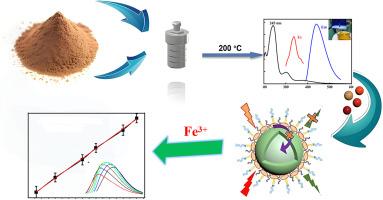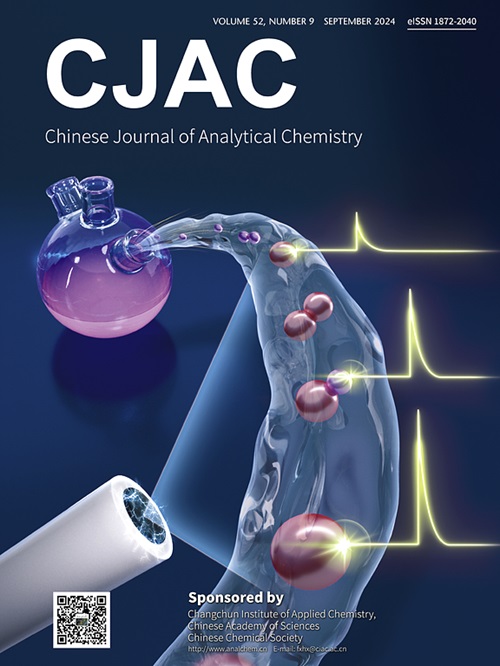Preparation of Auricularia auricula doped carbon-nitrogen quantum dots and their application in detecting heavy metal ions
IF 1.3
4区 化学
Q4 CHEMISTRY, ANALYTICAL
引用次数: 0
Abstract
This paper uses Auricularia auricula as the biological matrix material to synthesize carbon quantum dots (CQDs) with blue fluorescence by one step hydrothermal method. The characterization results by transmission electron microscope (TEM), X-ray diffraction (XRD), fourier transform infrared spectroscopy (FTIR), and X-ray photoelectron spectroscopy (XPS) indicate that CQDs are spherical in shape with an average particle size of 6 nm. The surface of CQDs contains hydrophilic groups such as hydroxyl, carboxyl, and amino groups, which have good water solubility. At the same time, CQDs have good fluorescence stability and excellent selectivity and anti-interference properties towards Fe3+. They exhibit good linearity in the range of 3–40 μmol/L, with a detection limit of 0.28 μmol/L. CQDs have been used as probes for the detection of Fe3+ content in tap water and mineral water, and satisfactory results have been obtained. Therefore, this probe has broad application prospects.

黑木耳掺杂碳氮量子点的制备及其在重金属离子检测中的应用
以黑木耳为生物基质材料,采用一步水热法制备了具有蓝色荧光的碳量子点。透射电镜(TEM)、x射线衍射(XRD)、傅里叶变换红外光谱(FTIR)和x射线光电子能谱(XPS)表征结果表明,CQDs为球形,平均粒径为6 nm。CQDs表面含有羟基、羧基、氨基等亲水性基团,具有良好的水溶性。同时,CQDs具有良好的荧光稳定性和对Fe3+的选择性和抗干扰性能。在3 ~ 40 μmol/L范围内线性良好,检出限为0.28 μmol/L。用CQDs作为探针检测自来水和矿泉水中的Fe3+含量,取得了满意的结果。因此,该探针具有广阔的应用前景。
本文章由计算机程序翻译,如有差异,请以英文原文为准。
求助全文
约1分钟内获得全文
求助全文
来源期刊
CiteScore
3.60
自引率
25.00%
发文量
17223
审稿时长
35 days
期刊介绍:
Chinese Journal of Analytical Chemistry(CJAC) is an academic journal of analytical chemistry established in 1972 and sponsored by the Chinese Chemical Society and Changchun Institute of Applied Chemistry, Chinese Academy of Sciences. Its objectives are to report the original scientific research achievements and review the recent development of analytical chemistry in all areas. The journal sets up 5 columns including Research Papers, Research Notes, Experimental Technique and Instrument, Review and Progress and Summary Accounts. The journal published monthly in Chinese language. A detailed abstract, keywords and the titles of figures and tables are provided in English, except column of Summary Accounts. Prof. Wang Erkang, an outstanding analytical chemist, academician of Chinese Academy of Sciences & Third World Academy of Sciences, holds the post of the Editor-in-chief.

 求助内容:
求助内容: 应助结果提醒方式:
应助结果提醒方式:


